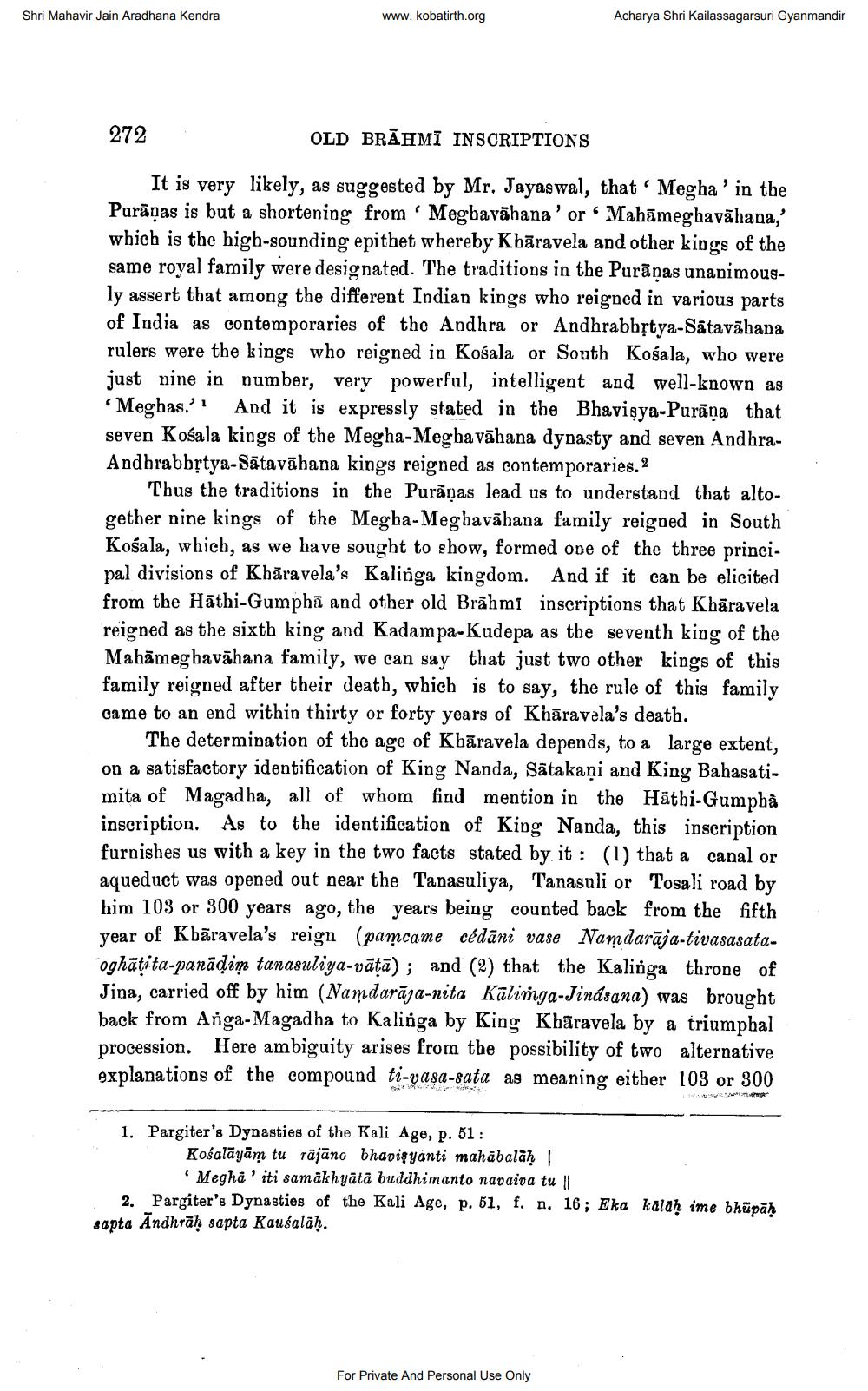________________
Shri Mahavir Jain Aradhana Kendra
272
www.kobatirth.org
OLD BRAHMI INSCRIPTIONS
6
It is very likely, as suggested by Mr. Jayaswal, that Megha' in the Purānas is but a shortening from Meghavahana' or Mahāmeghavahana,' which is the high-sounding epithet whereby Kharavela and other kings of the same royal family were designated. The traditions in the Puranas unanimously assert that among the different Indian kings who reigned in various parts of India as contemporaries of the Andhra or Andhrabbṛtya-Satavahana rulers were the kings who reigned in Kosala or South Kosala, who were just nine in number, very powerful, intelligent and well-known as 'Meghas.' And it is expressly stated in the Bhavisya-Purana that seven Kosala kings of the Megha-Meghavahana dynasty and seven AndhraAndhrabbṛtya-Satavahana kings reigned as contemporaries.2
Thus the traditions in the Puranas lead us to understand that altogether nine kings of the Megha-Meghavahana family reigned in South Kosala, which, as we have sought to show, formed one of the three principal divisions of Kharavela's Kalinga kingdom. And if it can be elicited from the Hathi-Gumpha and other old Brahmi inscriptions that Khāravela reigned as the sixth king and Kadampa-Kudepa as the seventh king of the Mahāmeghavahana family, we can say that just two other kings of this family reigned after their death, which is to say, the rule of this family came to an end within thirty or forty years of Kharavela's death.
The determination of the age of Kharavela depends, to a large extent, on a satisfactory identification of King Nanda, Satakani and King Bahasatimita of Magadha, all of whom find mention in the Hathi-Gumpha inscription. As to the identification of King Nanda, this inscription furnishes us with a key in the two facts stated by it: (1) that a canal or aqueduct was opened out near the Tanasuliya, Tanasuli or Tosali road by him 103 or 300 years ago, the years being counted back from the fifth year of Kharavela's reign (pamcame cédani vase Namdaraja-tivasasataoghatita-panaḍim tanasuliya-vāṭā); and (2) that the Kalinga throne of Jina, carried off by him (Namdaraja-nita Kalimga-Jindsana) was brought back from Anga-Magadha to Kalinga by King Kharavela by a triumphal procession. Here ambiguity arises from the possibility of two alternative explanations of the compound ti-vasa-sata as meaning either 103 or 300
1. Pargiter's Dynasties of the Kali Age, p. 51:
Acharya Shri Kailassagarsuri Gyanmandir
Kośalāyām tu räjāno bhavisyanti mahabalaḥ | 'Megha' iti samakhyātā buddhimanto navaiva tu |
2. Pargiter's Dynasties of the Kali Age, p. 51, f. n. 16; Eka kaldḥ ime bhupaḥ sapta Andhraḥ sapta Kausalaḥ.
For Private And Personal Use Only




